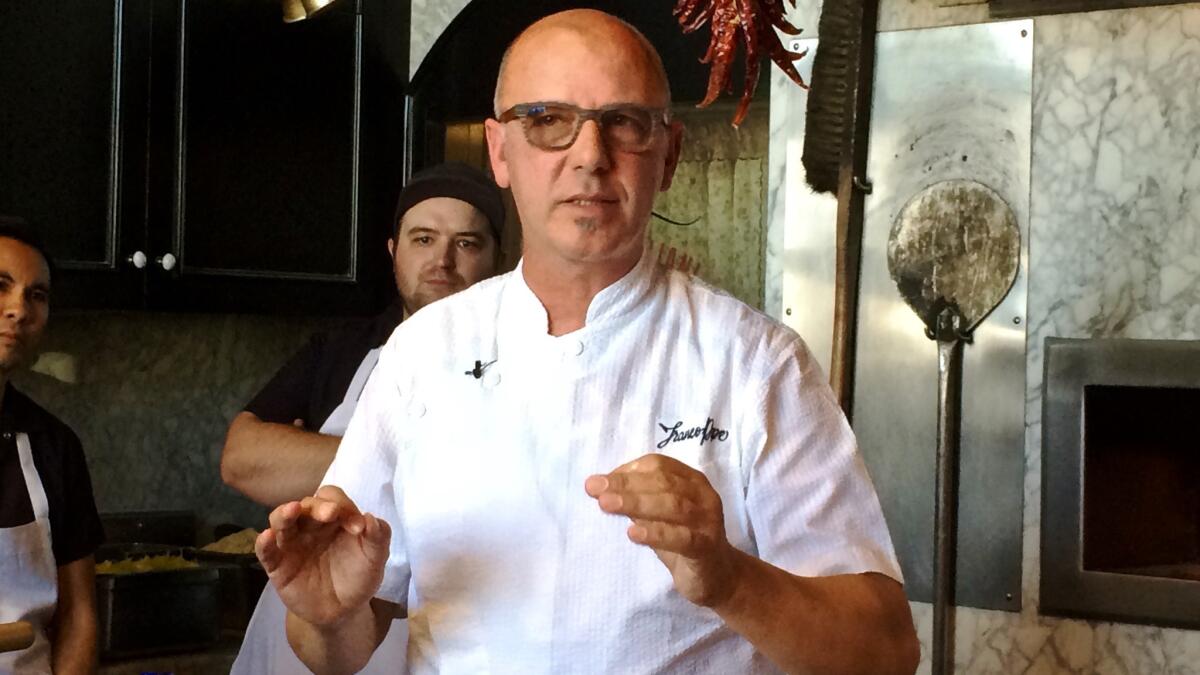Italian pizza master Franco Pepe visits the Mozza-plex

Franco Pepe in the Chi Spacca kitchen at Mozza on Nov. 19
- Share via
Chef Nancy Silverton confided to the group gathered Thursday in the Chi Spacca portion of the Mozza complex that she was a little nervous inviting Franco Pepe into her Hancock Park restaurant.
“Why am I inviting the best pizza maker in the world to my counter to show you how great pizza is really made?” Silverton asked the 40 or so people who came for the event.
That’s no overstatement. Pepe’s pizzeria has earned top honors from Italian food guide Gambero Rosso for three years in a row.
A third-generation pizza maker, Pepe’s grandfather started the family business in the tiny Campanian town of Caiazzo, which has a population of less than 6,000. But almost every night Pepe’s pizzeria, Pepe in Grani, is open, as many as 400 customers find their way down the narrow alleys to wait in lines that can last two hours.
Everything you need to know for Thanksgiving
One such customer was Silverton, who came away so impressed by Pepe’s pizza that she persuaded him to come to the United States on a tour that includes a stop at her restaurant.
On Thursday afternoon, Pepe gave a class on pizza-making; Thursday night, there was a dinner, also in the Chi Spacca space. Both are to be repeated Friday.
Silverton said she had been talked into driving to Caiazzo -- four hours from her home in Umbria -- by Italian food expert Faith Willinger. It took a couple of years to make her way, she said, but once she got there, she was convinced.
“I had been to all the places I was supposed to go in Naples, and honestly I just wasn’t that thrilled with the pizzas I was eating there,” she said. But when she got to Caiazzo, she realized there must be something special, “with 400 people patiently waiting in line for his pizza. When I sat down and had my first bite, I understood why.”
Pepe is not some rustic pizzaiolo, but one of the new breed of Italian gastro-philosophers. He opened Thursday’s class with three videos and a lecture on his philosophy of pizza-making, which revolves around paying attention to detail and making sure everything is done as well as it can be.
But that doesn’t mean he’s not open to experimentation. A big part of Pepe’s mystique is his dough-making, which is all done by hand (watch the 17-minute YouTube video of him preparing the dough). Yet he says he’s researching a mixer that can replicate the same gentle handling.
And though Pepe uses only a wood-burning oven at his restaurant, he’s selling an oven he says can get the same results without smoke or ash.
“He combines respect for tradition and old-school ways with great openness towards new ways,” said British pizza expert Daniel Young, who is one of those who touts Pepe as being one of the best in the world. He should know: His book “Where to Eat Pizza,” which features more than 1,700 pizza spots around the world, is to be published in April.
But enough background. What about the pizza? Pepe served five Thursday, each prepared by hand, one at a time. He used the same basis for each pizza, a highly hydrated dough that, even raw, feels light but strong. Cooked, it has a thin crusty shell and is extraordinarily tender yet chewy -- a hypnotic combination that is both earthy and ethereal.
Pepe started with a pizza fritta -- dough wrapped calzone-like around sheep’s milk ricotta and chopped salumi, and then deep-fried. Then came his version of Margherita (he calls it Margherita sbagliata, or “made wrong”) -- dough topped with mozzarella and baked before being painted with stripes of raw tomato and basil purees.
Then came some fantasies. Il Sole nel Piatto (the sun on the plate) is made by baking the crust with mozzarella and chopped tomatoes, then topping with black olives, anchovies and fresh basil. Sfizio ai Pomodori (whims of the tomato) is made with yellow tomatoes baked with mozzarella, with sun-dried cherry tomatoes added after. (“It’s a game with the sweet of the yellow and the saltiness of the sun-dried tomatoes,” he explained.)
A calzone that Pepe said was one of his favorites, because it reminded him of his father, was made with lettuces, capers, anchovies and green olives.
Then came a pizza made with mozzarella and onion cream and topped after baking with conserved tuna and celery that had been “cooked” by shaving it thin and soaking it on ice. Pepe called that Alleterate, named after a type of tuna caught off the Amalfi Coast.
After the class, when a student asked Pepe what he thought of the Mozza pie -- controversial in some pizza circles for its style -- he responded with what could have been an Italian Zen koan: “Every pizza maker makes his own pizza.”
Mozza, 6610 Melrose Ave., Los Angeles, (323) 297-1133, chispacca.com.
Are you a food geek? Follow me on Twitter @russ_parsons1
ALSO
13 affordable wines for the holiday table
Love dosas? Here’s a place you have to try
Jonathan Gold’s 101 best restaurants in Southern California
More to Read
Eat your way across L.A.
Get our weekly Tasting Notes newsletter for reviews, news and more.
You may occasionally receive promotional content from the Los Angeles Times.











